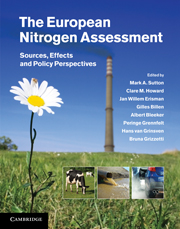Book contents
- Frontmatter
- Contents
- List of contributors
- Foreword
- Summary for policy makers
- Technical summary
- 1 Assessing our nitrogen inheritance
- Part I Nitrogen in Europe: the present position
- Part II Nitrogen processing in the biosphere
- Part III Nitrogen flows and fate at multiple spatial scales
- Part IV Managing nitrogen in relation to key societal threats
- 17 Nitrogen as a threat to European water quality
- 18 Nitrogen as a threat to European air quality
- 19 Nitrogen as a threat to the European greenhouse balance
- 20 Nitrogen as a threat to European terrestrial biodiversity
- 21 Nitrogen as a threat to European soil quality
- Part V European nitrogen policies and future challenges
- Glossary
- Index
- References
20 - Nitrogen as a threat to European terrestrial biodiversity
from Part IV - Managing nitrogen in relation to key societal threats
Published online by Cambridge University Press: 16 May 2011
- Frontmatter
- Contents
- List of contributors
- Foreword
- Summary for policy makers
- Technical summary
- 1 Assessing our nitrogen inheritance
- Part I Nitrogen in Europe: the present position
- Part II Nitrogen processing in the biosphere
- Part III Nitrogen flows and fate at multiple spatial scales
- Part IV Managing nitrogen in relation to key societal threats
- 17 Nitrogen as a threat to European water quality
- 18 Nitrogen as a threat to European air quality
- 19 Nitrogen as a threat to the European greenhouse balance
- 20 Nitrogen as a threat to European terrestrial biodiversity
- 21 Nitrogen as a threat to European soil quality
- Part V European nitrogen policies and future challenges
- Glossary
- Index
- References
Summary
Executive summary
Nature of the problem
Biodiversity is the variability among living organisms, from genes to the biosphere. The value of biodiversity is multifold, from preserving the integrity of the biosphere as a whole, to providing food and medicines, to spiritual and aesthetic well-being.
One of the major drivers of biodiversity loss in Europe is atmospheric deposition of reactive nitrogen (Nr).
Approaches
This chapter focuses on Nr impacts on European plant species diversity; in particular, the number and abundance of different species in a given area, and the presence of characteristic species of sensitive ecosystems.
We summarise both the scientific and the policy aspects of Nr impacts on diversity and identify, using a range of evidence, the most vulnerable ecosystems and regions in Europe.
Key findings/state of knowledge
Reactive nitrogen impacts vegetation diversity through direct foliar damage, eutrophication, acidification, and susceptibility to secondary stress.
Species and communities most sensitive to chronically elevated Nr deposition are those that are adapted to low nutrient levels, or are poorly buffered against acidification. Grassland, heathland, peatland, forest, and arctic/montane ecosystems are recognised as vulnerable habitats in Europe; other habitats may be vulnerable but are still poorly studied.
It is not yet clear if different wet-deposited forms of Nr (e.g. nitrate, NO3− versus ammonium, NH4+) have different effects on biodiversity. However, gaseous ammonia (NH3) can be particularly harmful to vegetation, especially lower plants, through direct foliar damage.
[…]
- Type
- Chapter
- Information
- The European Nitrogen AssessmentSources, Effects and Policy Perspectives, pp. 463 - 494Publisher: Cambridge University PressPrint publication year: 2011
References
- 68
- Cited by

